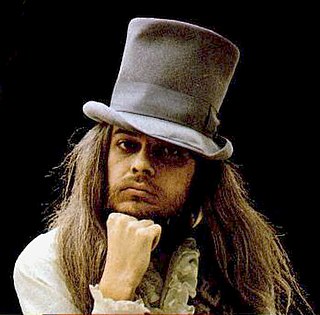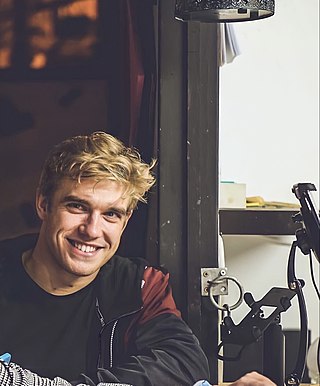Leon Campbell may refer to:
Leon Campbell may refer to:

Glen Travis Campbell was an American country singer, guitarist, songwriter, and actor. He was best known for a series of hit songs in the 1960s and 1970s, and for hosting The Glen Campbell Goodtime Hour on CBS television from 1969 until 1972. He released 64 albums in a career that spanned five decades, selling over 45 million records worldwide, including twelve gold albums, four platinum albums, and one double-platinum album.

Leon Redbone was a singer-songwriter and musician specializing in jazz, blues, and Tin Pan Alley classics. Recognized by his hat, dark sunglasses, and black tie, he was born in Cyprus of Armenian ancestry and first appeared on stage in Toronto, Canada, in the early 1970s. He also appeared on film and television in acting and voice-over roles.

Leon Russell was an American musician and songwriter who was involved with numerous bestselling records during his 60-year career that spanned multiple genres, including rock and roll, country, gospel, bluegrass, rhythm and blues, southern rock, blues rock, folk, surf and the Tulsa sound. His recordings earned six gold records and he received two Grammy Awards from seven nominations. In 1973 Billboard named Russell the "Top Concert Attraction in the World". In 2011, he was inducted into both the Rock and Roll Hall of Fame and the Songwriters Hall of Fame.

Thomas Leon Preston Campbell is an Australian former professional rugby league footballer who played as a five-eighth or fullback in the National Rugby League (NRL) for the Cronulla-Sutherland Sharks, the Penrith Panthers and the Gold Coast Titans. He was also a New South Wales Country, Dreamtime Team and Indigenous All Stars representative. He is considered to be one of the best players to never play State of Origin

André Leon Talley was an American fashion journalist, stylist, creative director, author, and editor-at-large of Vogue magazine. He was the magazine's fashion news director from 1983 to 1987, its first African-American male creative director from 1988 to 1995, and then its editor-at-large from 1998 to 2013. Often regarded as a fashion icon, he was known for supporting emerging designers and advocating for diversity in the fashion industry; while the capes, kaftans, and robes he wore became his trademark look. Talley also served on the judging panel for America's Next Top Model.

Leon George Thomas III is an American singer, songwriter, record producer, and actor. After early roles in Broadway and providing the singing voice of Tyrone on the Nick Jr. animated series The Backyardigans (2006–2008), he played Andre Harris on the Nickelodeon series Victorious (2010–2013), for which he received an NAACP Image Award nomination.
A cleaner is an industrial or domestic worker who cleans.

The Essential Glen Campbell Volume Two is the second of a series of three albums which cover Glen Campbell's recordings for Capitol Records between 1962 and 1979. The tracks are presented in a non-chronological order. All three Essential CDs contain, next to single and albums tracks, previously unreleased recordings. On The Essential Glen Campbell Volume Two, these are "My Special Angel", an uptempo version of "Last Thing on My Mind", "Oh Boy" and "Don't It Make You Want To Go Home". The Essential albums are also notable for containing some of the songs from The Artistry of Glen Campbell, the only original studio album by Glen Campbell that has not been released on CD or as a digital download. Included here is "Greensleeves".

The Essential Glen Campbell Volume Three is the third of a series of three albums which cover Glen Campbell's recordings for Capitol Records from 1962-79. The tracks are presented in a non-chronological order. All three Essential CDs contain, next to single and albums tracks, previously unreleased recordings. On The Essential Glen Campbell Volume Three, these are "Beautiful Brown Eyes", "They'll Never Take Her Love from Me", "All the Way" and "Learnin' the Blues". The last two songs are from a 1979 recording session led by Nelson Riddle. The Essential albums are also notable for containing some of the songs from The Artistry of Glen Campbell, the only original studio album by Campbell that has not been released on CD or as a digital download. Included here is "Tequila".

"Galveston" is a song written by Jimmy Webb and popularized by American country music singer Glen Campbell who recorded it with the instrumental backing of members of The Wrecking Crew. In 2003, this song ranked number 8 in CMT's 100 Greatest Songs in Country Music. Campbell's version, produced by Al De Lory, also went to number 1 on the country music charts. On other charts, "Galveston" went to number 4 on the Billboard Hot 100 and number one on the "Easy Listening" charts. It was certified gold by the RIAA in October 1969.
Leon L. Campbell was an American football fullback who played five seasons in the National Football League (NFL) for the Baltimore Colts, the Chicago Bears, and the Pittsburgh Steelers. Campbell played college football at the University of Arkansas before being a 2nd round selection in the 1950 NFL draft.

Burning Bridges is the fifth album by American singer-guitarist Glen Campbell, released in 1967 by Capitol Records.

Glen Campbell's Greatest Hits was the first official Capitol compilation album by Glen Campbell and was released in 1971. The Best of Glen Campbell followed in 1976, covering his later hits in addition to five on this compilation.

Wedding Album is a studio album by Leon Russell and his then wife, Mary Russell, otherwise known as Mary McCreary. It was the first album released on Leon Russell's record label, Paradise Records, which was distributed by Warner Bros. Records. Leon and Mary Russell are also credited as producers of the album, with the exception of the final track, "Daylight", which was produced by its writer, Bobby Womack.

Gregory Lloyd Campbell is a British Democratic Unionist Party (DUP) politician who has been the Member of Parliament (MP) for East Londonderry since 2001. As of 2024, Campbell is Northern Ireland's longest-serving current MP. He is the DUP Spokesperson for International Development.

Joel Nathaniel Campbell Samuels is a Costa Rican professional footballer who plays as a forward for Atlético Gonianiense on loan from Liga FPD club Alajuelense and the Costa Rica national team.
Jesse Campbell is an American R&B singer. He was a member of Team Christina in the second season of the American television talent show The Voice.

The Coahuiltecan were various small, autonomous bands of Native Americans who inhabited the Rio Grande valley in what is now northeastern Mexico and southern Texas. The various Coahuiltecan groups were hunter gatherers. First encountered by the Spanish in the 16th century, their population declined due to Old World diseases and numerous small-scale wars fought against the Spanish, Apache, and other Indigenous groups.

Bobby Lockwood is an English actor. He is known for his roles as Mick Campbell in House of Anubis (2011–2012) and as Rhydian Morris in Wolfblood (2012–2014). In 2021, he appeared on the BBC medical drama series Casualty as Leon Cook.
C'mon Baby or Come On Baby may refer to: